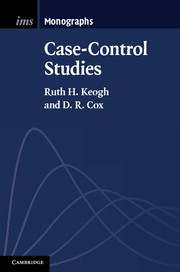Book contents
- Frontmatter
- Contents
- Preface
- Preamble
- Notes
- 1 Introduction to case-control studies
- 2 The simplest situation
- 3 Matched case-control studies
- 4 A general formulation
- 5 Case-control studies with more than two outcomes
- 6 Special sampling designs
- 7 Nested case-control studies
- 8 Case-subcohort studies
- 9 Misclassification and measurement error
- 10 Synthesis of studies
- Appendix: A theoretical diversion
- References
- Index
8 - Case-subcohort studies
Published online by Cambridge University Press: 05 April 2014
- Frontmatter
- Contents
- Preface
- Preamble
- Notes
- 1 Introduction to case-control studies
- 2 The simplest situation
- 3 Matched case-control studies
- 4 A general formulation
- 5 Case-control studies with more than two outcomes
- 6 Special sampling designs
- 7 Nested case-control studies
- 8 Case-subcohort studies
- 9 Misclassification and measurement error
- 10 Synthesis of studies
- Appendix: A theoretical diversion
- References
- Index
Summary
The case-subcohort design, often called simply the case-cohort design, is an alternative to the nested case-control design for case-control sampling within a cohort.
The primary feature of a case-subcohort study is the ‘subcohort’, which is a random sample from the cohort and which serves as the set of potential controls for all cases. The study comprises the subcohort plus all additional cases, that is, those not in the subcohort.
In an analysis using event times the cases are compared with members of the subcohort who are at risk at their event time, using a pseudo-partial likelihood. This results in estimates of hazard ratios.
An advantage of this design is that the same subcohort can be used to study cases of different types.
A simpler form of case-subcohort study disregards event times and is sometimes referred to as a case-base study or hybrid epidemiologic design. In this the subcohort enables estimation of risk ratios and odds ratios.
Preliminaries
In this chapter we continue the discussion of studies described broadly as involving case-control sampling within a cohort. In the nested case-control design, discussed in Chapter 7, cases are compared with controls sampled from the risk set at each event time. A feature of the nested case-control design is that the sampled controls are specific to a chosen outcome and therefore cannot easily be re-used in studies of other outcomes of interest if these occur at different time points; in principle, at least, a new set of controls must be sampled for each outcome studied though some methods have been developed that do enable the re-use of controls.
Information
- Type
- Chapter
- Information
- Case-Control Studies , pp. 191 - 211Publisher: Cambridge University PressPrint publication year: 2014
Accessibility standard: Unknown
Why this information is here
This section outlines the accessibility features of this content - including support for screen readers, full keyboard navigation and high-contrast display options. This may not be relevant for you.Accessibility Information
- 2
- Cited by
